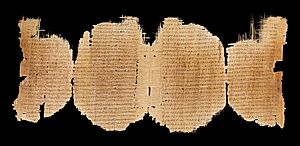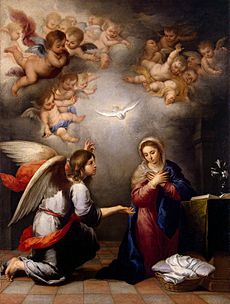Gospel of Luke facts for kids
Quick facts for kids Gospel of Luke |
|
|---|---|
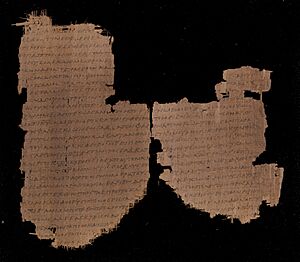
Luke 13:29–14:10 on Papyrus 45 (recto; c. AD 250)
|
|
| Information | |
| Religion | Christianity |
| Author | Anonymous (traditionally attributed to Luke the Evangelist) |
| Language | Koine Greek |
| Period | c. 80-90 AD |
| Chapters | 24 |
| Verses | 1,151 |
The Gospel of Luke is one of the four main books in the New Testament of the Bible. It tells the amazing story of Jesus: his beginnings, his birth, his life and teachings, his death, his return to life, and his return to heaven.
This book is actually the first part of a two-part story. The second part is called the Acts of the Apostles. Together, these two books make up a big chunk of the New Testament. They describe the early history of Christianity in three main stages. The Gospel of Luke covers the first two stages: Jesus' life from birth until he met John the Baptist, and then his public work, including famous teachings like the Sermon on the Plain and his final days.
Most experts believe that the writer of Luke used information from the Gospel of Mark and another collection of Jesus' sayings, often called "Q." The author also added unique stories, sometimes called "L" material. We don't know the author's name for sure, but many believe it was Luke the Evangelist, a friend of Paul the Apostle. The book was likely written around 80-90 AD.
Luke's Gospel starts with a special message to someone named Theophilus. It then tells about the births of John the Baptist and Jesus. The story begins in Galilee and slowly moves towards its important ending in Jerusalem. Luke shows history in three parts: first, the time of the Law and the prophets; second, the time of Jesus; and third, the time of the early church. The book also highlights the important role of the Holy Spirit.
Contents
Discovering the Gospel of Luke
What is the Gospel of Luke?
The Gospel of Luke is one of the four important books in the New Testament of the Bible. It tells the story of Jesus' life, from his birth to his return to heaven. This book is actually the first part of a two-volume work. The second part is called the Acts of the Apostles. Together, they make up a large portion of the New Testament. These books help us understand the early history of Christianity.
Who Wrote the Gospel of Luke?
The author of Luke's Gospel doesn't mention their name in the book. However, many people traditionally believe it was Luke the Evangelist. He was known as a companion of Paul the Apostle. Some scholars today discuss if the author was indeed this Luke, because there are some differences between the stories in Acts and Paul's own letters. Still, most agree that the author knew Paul at some point. The writer was educated and likely lived in a city.
When Was It Written?
Most experts believe that the Gospel of Luke, along with the book of Acts, was written around 80-90 AD. This means it was written several decades after Jesus lived. The earliest surviving copies of Luke's Gospel are very old manuscripts. For example, Papyrus 75 is a very early copy from the late 2nd or early 3rd century. Other important old copies include Codex Sinaiticus and Vaticanus from the 4th century. These ancient texts help us understand how the Gospel was passed down.
How Luke Gathered His Information
The author of Luke's Gospel explains that he carefully investigated everything. He wanted to write an "orderly account" based on what eyewitnesses had shared. Most scholars think he used the Gospel of Mark as a main source for the story's outline. He also likely used a collection of Jesus' sayings, which scholars call "Q." Besides these, Luke included many unique stories and teachings not found in other gospels. These unique parts are sometimes called "L" material.
Who Was Luke Writing For?
Luke wrote his Gospel for an educated, Greek-speaking audience. He started his book with a special message to someone named "Theophilus," which means "Lover of God." This person might have been a Christian convert or someone who supported Luke's writing. Luke's goal was to give his readers a clear and reliable understanding of Jesus' life and what it all meant. He wanted to strengthen their faith.
The Story Luke Tells
Luke's Gospel tells a continuous story that begins in Galilee and builds up to important events in Jerusalem. It follows a clear path, showing how God's plan unfolded through Jesus.
Jesus' Birth and Early Life
The Gospel starts with a special introduction to Theophilus. Then, it tells the stories of the births of both John the Baptist and Jesus. These birth stories are presented as the beginning of a new, promised era for God's people. We learn about Jesus' childhood and how he grew up.
Jesus' Journey and Teachings
After his early life, Jesus begins his important mission. This includes John the Baptist preparing the way for him, Jesus' own baptism, and a time when his faith was tested. The story then moves to Jesus' work in Galilee, where he taught many people and performed miracles. Not everyone welcomed him, and he faced some opposition. A large part of Luke's Gospel describes Jesus' journey towards Jerusalem. He knew that this journey would lead to his destiny as God's prophet and Messiah. During this journey, he shared many of his most famous teachings and parables.
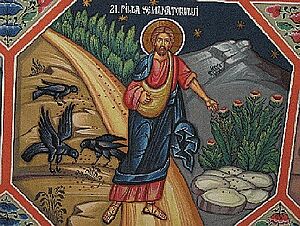
The Final Days and Resurrection
Jesus' mission continues in Jerusalem, where he faced challenges from the leaders of the Jewish Temple. The Gospel describes his Last Supper with his closest followers, his arrest, questioning, and finally, his crucifixion. But the story doesn't end there! Luke tells us about Jesus' return to life after his death. These events, from the first Easter to Jesus' ascension into heaven, show that his death was part of God's plan. They also set the stage for the story that continues in the Acts of the Apostles.
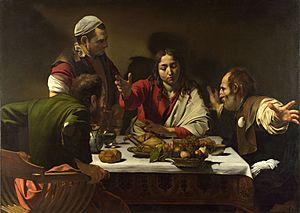
Important Ideas in Luke's Gospel
Luke's Gospel shares many important ideas about God, Jesus, and the early Christian community. These ideas are woven throughout the stories and teachings.
God's Plan Through History
Luke shows us a big picture of history, which he sees as God's plan unfolding in three main stages. First, there was the time of "the Law and the Prophets," which started with the earliest stories in the Bible and ended with John the Baptist. Second, came the time of Jesus, when the Kingdom of God was announced. Finally, there is the time of the Church, which began after Jesus returned to heaven. This stage continues until Jesus comes again.
Who is Jesus?
A central idea in Luke's Gospel is understanding who Jesus is. Luke uses several important titles for Jesus, such as Messiah (also called Christ), Lord, Son of God, and Son of Man. These titles help explain Jesus' special role and identity. Luke also connects Jesus to important figures and ideas from the Old Testament, showing that Jesus is the promised Messiah. He is presented as the greatest of all saviors, a message that would have been clear to people familiar with ancient leaders and heroes.
The Holy Spirit's Role
The Holy Spirit is very important in Luke's Gospel and the book of Acts. The Spirit is shown guiding Jesus throughout his life and mission. It also empowers the early Christian community. Luke teaches that the Spirit helps believers live together in unity and share everything they have. This shared life, guided by the Spirit, forms the basis of the Christian community, which can also be seen as the Kingdom of God.
Early Christians and Their World
Luke's Gospel also helps us understand the place of early Christians in the world. It shows that while Christians were not a threat to the Roman Empire, their main loyalty was to God. Luke also highlights that Jesus and his first followers were Jews. Even though many non-Jewish people later joined the Christian faith, Luke emphasizes the Jewish roots of Christianity.
How Luke Compares to Other Gospels
The Gospel of Luke is often read alongside the other Gospels, and it's interesting to see how they are similar and different.
Luke and the Other Synoptic Gospels
The Gospels of Matthew, Mark, and Luke are called the Synoptic Gospels because they tell many of the same stories in similar ways. Most scholars believe that Mark was written first, around 70 AD. Then, Matthew and Luke used Mark's Gospel as a guide. They also likely used another collection of Jesus' sayings, called "Q." Luke expanded on Mark's stories and made the writing style more refined. He also included many unique stories and teachings that are not found in Mark or Matthew. For example, Luke often shows Peter in a more positive light than some other Gospels.
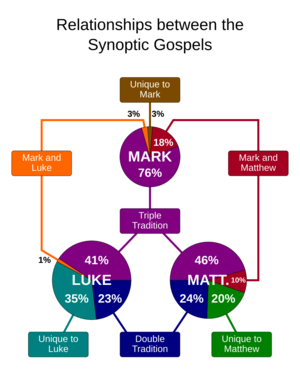
Luke and the Gospel of John
Even though Luke is grouped with Matthew and Mark, it also shares some interesting similarities with the Gospel of John that the other Synoptic Gospels don't have. For instance, both Luke and John use the terms "Jews" and "Israelites" in a similar way. They also both mention characters like Mary of Bethany, Martha, and Lazarus. In the story of Jesus' arrest, only Luke and John mention that the servant's right ear was cut off. Some scholars even think that the author of John's Gospel might have known and responded to Luke's Gospel.
Different Versions of Luke's Story
In the early days of Christianity, there were sometimes different versions of the same stories. For example, in the 2nd century, a Christian thinker named Marcion of Sinope used a version of Luke's Gospel that was shorter than the one we have today. Marcion's version did not include the birth story of Jesus or the parable of the Good Samaritan and the Prodigal Son. This shows that early Christians sometimes had slightly different texts of the Gospels.
Related pages
Images for kids
See also
 In Spanish: Evangelio de Lucas para niños
In Spanish: Evangelio de Lucas para niños


